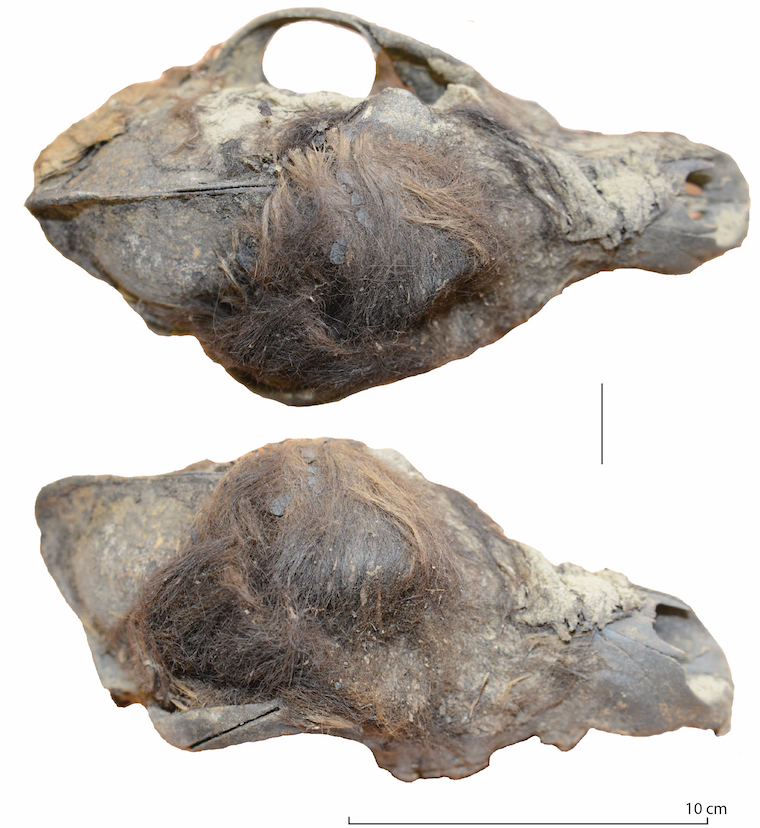Ever share table scraps with your pup? Research suggests your ancient relatives probably did, too.
Two University of Saskatchewan professors, Robert Losey, Ph.D., and Tatiana Nomokonova, Ph.D., study the development of dog diets. Interestingly — but perhaps not surprisingly — the researchers found that they usually reflected that of their human companions.
The study also reveals that ancient dog parents considered their pups “family members,” Losey told DogTime.
With archaeological evidence from Siberia, the researchers compared dog diets to what wolves were eating during the same time period. Their new research shows that bones and feces from ancient dogs harbor evidence of dog diets. The researchers even found some fossilized animal excrement buried in human graves.

Fossilized Animal Excrement: Underappreciated Resource
This research highlights how much can be gleaned from fossilized animal excrement, a historically untapped and underappreciated resource.
“Usually in archaeology, human material is difficult to get a hold of,” Nomokonova told Saskatoon CTV News, “But no one is fighting over dog poop.”
Although excavation in cemeteries all over Siberia started in the 1950s, researchers recently discovered how much information ancient feces provides.

Losey said that ancient dog toenails and hair buried in the permafrost can also reflect their diet, even over a few weeks. For example, if a diet comprises burgers for a month and then switches to salmon, that change can be seen in their DNA.
Localized Pattern in Diets
Losey said dog diets showed localized patterns. Dogs that were living with people on the seashore had marine diets. At some point in pre-history, agriculture boomed. With it, dogs incorporated grains in their diet.
“Northern dogs don’t have the ability to digest grain. Even today, some dogs are fine with grain, but others won’t thrive, depending on the kind of dog,” explained Losey.
Ancient Burial Methods for Man’s Best Friend
Our ancestors treated their dogs like members of the family. They placed them in graves and cemeteries just like their other family members.
“The dog graves with humans were found around Lake Baikal in southern Siberia. Most dog remains we studied were buried with people and 20 to 30 dogs had their own graves,” said Losey, who started this research 17 years ago. “Someone found out that I was interested in dogs and told me they have some burials,” he says, with a chuckle.

“This speaks to the intimate connection people have with their dogs. We thought this must carry out across all of their lives, including how their dogs were treated in life and including how they were fed by the people that they lived with,” Losey told CTV News.
Most all researchers agree that modern day dogs evolved from grey wolves during the last Ice Age, about 15,000 years ago. Still, researchers are fighting over where and when wolves became humans’ loyal companions. In fact, the jury was out until the late 1990s, when genetic analyses finally confirmed that dogs share 99.9 percent of their DNA with grey wolves, reported the journal Science.
The Roll of Diet in Domestication
The study, which was published in Science Advances, shows that wolves often ate grass-fed animals.
“While wolves are large-bodied animals and they can hunt these types of prey effectively, our research shows that dogs quickly evolved to have smaller bodies than wolves, and this likely changed their abilities and diets,” said Losey.
So, even thousands of years ago, dogs were a different animal than wolves. Not only were they smaller, but Losey says that they also had less strong jaws. Additionally, Losey says, “they were probably less effective at running long distances, had reduced abilities to hunt large prey, and probably relied more on handouts from people and scavenging.”
So, what came first: diet or size?
“We don’t exactly know why there was a tendency to be smaller, but the change in diet and behavior was likely a parallel occurrence,” explains Losey.
Future Research
According to the University of Saskatchewan website, Losey and Nomokonova will continue to study the lives of dogs in other parts of the world.
“Every time we see remarkable remains, we get so excited. But the sad part is when someone else finds them and we are usually late to the party,” says Losey, laughing, “We get excited in the lab.”
“Right now, I’m in Alaska, interviewing elders about how they cared for and fed their dogs. And they know more than archeologists do. If I had a sled dog here, I would not be feeding them grain,” explains Losey.

Further analysis in these areas allows exploration into how cohabiting with humans influences the development of a species. Losey says their research is expanding into Indigenous communities. They will look at diets and size in indigenous dogs in North America, particularly on the Prairies and in the Arctic.
In further research, Losey will explore how Indigenous people cared for their dogs in the past. This includes “how and when” Indigenous people involved dogs in tasks “such as pulling sleds.”
“The most direct outcome benefit for humans is to see the unique relationships with dogs,” remarks Losey. This includes studying partnerships between humans and animals. Specifically, Losey will study how this relationship affected migrations on the plains and daily lives. He also adds that these findings relate to colonialism — but that’s another story.
As for any benefits for dogs, Losey says that looking at indigenous dogs is interesting. “We lost a lot of diversity because of modern breeding practices, and that’s a case against purebreds,” explains Losey.
And again, that’s another story.









